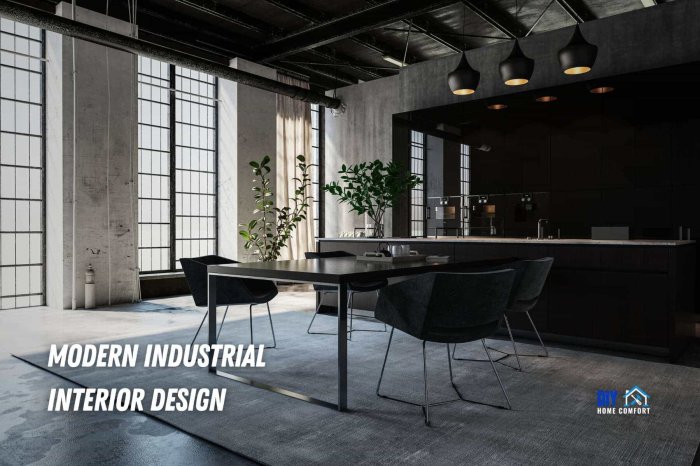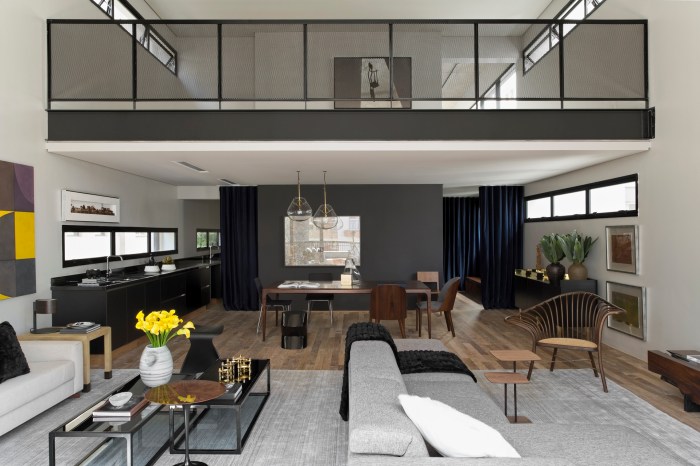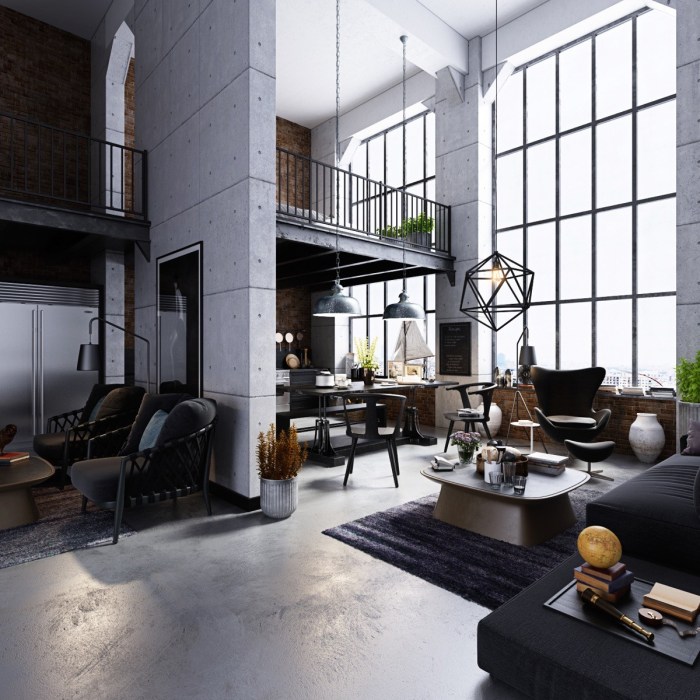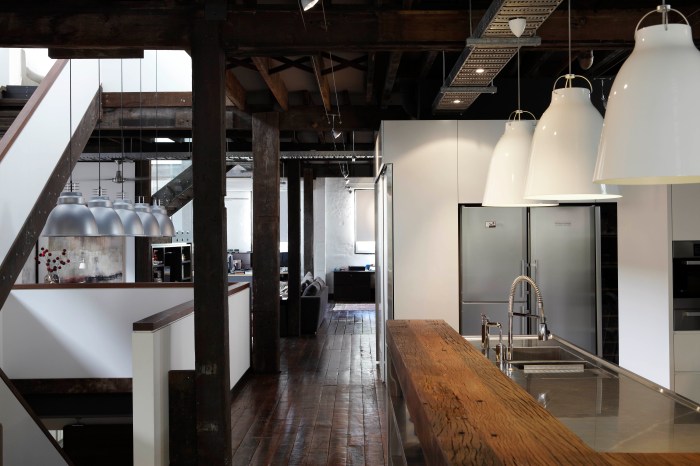Modern industrial interior design, a captivating blend of raw aesthetics and contemporary functionality, has emerged as a dominant force in the world of home decor. This style, born from the repurposing of old factories and warehouses, celebrates exposed brick, metal piping, and concrete floors, yet seamlessly integrates modern amenities and technology. Its appeal lies in the striking juxtaposition of rough textures with sleek lines, creating spaces that are both visually arresting and surprisingly comfortable.
We will delve into the defining characteristics, material choices, lighting strategies, furniture selection, and technological integration that define this unique and enduring style.
From the stark beauty of exposed ductwork to the warm embrace of reclaimed wood, modern industrial design offers a unique opportunity to craft a space that reflects both a reverence for the past and an embrace of the future. The careful selection of materials, the strategic placement of lighting, and the thoughtful integration of furniture all contribute to the creation of an environment that is both functional and aesthetically pleasing.
This exploration will guide you through the nuances of this style, providing a comprehensive understanding of its key elements and how to successfully incorporate them into your own living space.
Defining Modern Industrial Style

Modern industrial interior design represents a fascinating blend of functionality and aesthetics, drawing inspiration from the raw, utilitarian spaces of early 20th-century factories and warehouses. It transcends a mere imitation of industrial spaces, however, evolving into a sophisticated style that incorporates contemporary elements and a focus on comfort. This style prioritizes the honest expression of materials and a sense of spaciousness, creating environments that are both visually striking and surprisingly welcoming.Modern industrial style is characterized by its unique interplay of contrasting elements.
It expertly balances the rough textures of exposed brick and metal with the sleek lines of contemporary furniture and fixtures. This juxtaposition creates a dynamic tension that defines the style’s distinctive appeal. The emphasis is always on functionality, with design choices driven by practicality as much as by aesthetics. The overall effect is a space that feels both lived-in and meticulously curated.
Key Characteristics of Modern Industrial Interior Design
Modern industrial interiors are defined by several core characteristics. Exposed brick walls, often left with their original patina, are a hallmark feature. High ceilings, large windows that flood the space with natural light, and the strategic use of metallic elements, such as steel pipes or industrial-style lighting fixtures, further contribute to the style’s signature aesthetic. The use of reclaimed wood, often left with its natural imperfections, adds a touch of rustic charm, balancing the starkness of the metallic components.
Finally, a neutral color palette forms the foundation, allowing the raw materials and textures to take center stage.
Comparison with Other Interior Design Styles
Modern industrial style differs significantly from other design trends. Unlike minimalist design, which prioritizes clean lines and a sparse aesthetic, modern industrial embraces a more textured and layered look. While both styles often utilize a neutral color palette, minimalism avoids ornamentation entirely, whereas industrial design often incorporates exposed pipes, beams, and other structural elements as decorative features. In contrast to rustic styles, which rely heavily on warm, natural materials and a sense of cozy imperfection, modern industrial maintains a cleaner, more sophisticated edge, often integrating sleek, contemporary furniture pieces alongside the raw materials.
Use of Raw Materials and Exposed Elements
The use of raw, unfinished materials is a defining feature of modern industrial design. Exposed brick walls, concrete floors, and steel beams are not merely structural elements; they are integral components of the aesthetic. These materials are often left in their natural state, showcasing their inherent textures and imperfections. Reclaimed wood, with its visible grain and knots, adds another layer of texture and a touch of history.
This deliberate showcasing of raw materials creates a sense of authenticity and a connection to the industrial past, while simultaneously providing a unique and visually compelling backdrop for more contemporary furnishings.
Typical Color Palettes in Modern Industrial Interiors
Modern industrial interiors typically employ a neutral color palette as a foundation. Shades of gray, beige, and white are commonly used to create a clean, uncluttered backdrop that allows the raw materials and textures to stand out. Black is often incorporated as an accent color, adding depth and contrast. Metallic accents, such as copper, brass, or steel, further enhance the industrial feel.
While pops of color can be incorporated, they are usually used sparingly to avoid overwhelming the overall aesthetic and maintain the style’s characteristic balance. The color palette emphasizes a sense of spaciousness and light, letting the raw materials speak for themselves.
Material Selection and Application

The judicious selection and application of materials are paramount in achieving the signature aesthetic of modern industrial design. This style, born from the repurposing of factory spaces, celebrates the raw beauty of utilitarian materials, emphasizing texture, contrast, and a sense of honest construction. The choice of materials directly impacts the overall feel, durability, and functionality of the space.The successful execution of a modern industrial design hinges on a carefully curated material palette.
This palette balances the inherent ruggedness of industrial elements with the clean lines and sophistication expected in contemporary design. Understanding the properties and aesthetic contributions of each material is crucial.
Material Palette for a Modern Industrial Space
A sample material palette might include exposed brick, its rough texture providing a historical backdrop; polished concrete floors, offering durability and a sleek, minimalist counterpoint; reclaimed wood beams, adding warmth and visual interest through their varied grain and patina; blackened steel accents, introducing a sophisticated industrial edge; and brushed brass fixtures, lending a touch of luxury and contrast to the otherwise muted palette.
The exposed brick could form an accent wall, showcasing its inherent texture. The polished concrete would provide a seamless, low-maintenance floor surface. Reclaimed wood beams could be incorporated into the ceiling structure, adding a rustic element. Blackened steel could be used for shelving or light fixtures, while brushed brass would be ideal for door handles and light switches.
The Importance of Texture and Contrast in Material Selection
Texture and contrast are fundamental to the success of a modern industrial design. The juxtaposition of smooth and rough surfaces, matte and glossy finishes, and warm and cool tones creates visual depth and interest. For instance, the smooth, cool surface of a polished concrete floor contrasts beautifully with the rough, warm texture of exposed brick walls. This interplay prevents the space from feeling monotonous and enhances its overall character.
The contrasting textures also stimulate different sensory experiences, enriching the overall ambiance. Consider the tactile difference between the smooth metal of a pipe and the rough-hewn surface of a reclaimed wood table. This interplay of textures elevates the design beyond the purely visual.
Effective Combination of Different Materials
The effective combination of materials is key to creating a cohesive and visually appealing space. For example, pairing the raw, unfinished look of concrete with the warmth of reclaimed wood creates a balanced aesthetic. The cool tones of metal can be softened by incorporating natural wood elements, while the industrial feel of steel can be elevated with the introduction of sleek, polished concrete.
A strategic approach to material combination allows designers to control the visual weight and flow within the space. Think of a loft apartment with exposed brick walls, concrete floors, and reclaimed wood shelving—a classic example of harmonious material integration. The rough texture of the brick contrasts with the smooth concrete, while the wood adds warmth and visual break.
Comparison of Commonly Used Materials
| Material | Pros | Cons | Applications |
|---|---|---|---|
| Exposed Brick | Adds character, texture, and historical feel; durable | Can be difficult to clean; may require sealing | Accent walls, fireplaces |
| Reclaimed Wood | Unique character, adds warmth; sustainable | Can be expensive; requires maintenance | Flooring, shelving, beams |
| Polished Concrete | Durable, low-maintenance, modern aesthetic | Can be cold to the touch; prone to staining (if not sealed properly) | Floors, countertops |
| Steel | Strong, durable, industrial aesthetic | Can rust; requires maintenance (depending on finish) | Shelving, light fixtures, structural elements |
Lighting and Ambiance
The judicious application of lighting is paramount in shaping the atmosphere of a modern industrial interior. Unlike styles that prioritize soft, diffused light, modern industrial design leverages the interplay of light and shadow to highlight the raw textures and structural elements inherent in the aesthetic. The goal is not to eliminate shadows, but to use them strategically to create depth and visual interest, mirroring the inherent contrasts found in repurposed factories and warehouses that inspire the style.
The choice of lighting fixtures, their placement, and the intensity of the light emitted directly impact the overall mood and functionality of the space.Lighting fixtures in a modern industrial setting should complement the raw, utilitarian aesthetic. The interplay of light and shadow enhances the exposed brick, metal pipes, and concrete surfaces, creating a visually stimulating environment.
Suitable Lighting Fixtures for Modern Industrial Interiors
The selection of lighting fixtures is crucial in achieving the desired ambiance. Several options effectively capture the essence of modern industrial style. Exposed filament bulbs within metal cages, for example, offer a blend of vintage charm and industrial ruggedness. Their warm, incandescent glow contrasts beautifully against the cooler tones of metal and concrete. Conversely, sleek, linear LED fixtures mounted on exposed beams or ceilings provide a contemporary counterpoint, highlighting the architectural features of the space.
Track lighting systems allow for flexible illumination, enabling targeted lighting of specific areas, such as artwork or display cases. Pendant lights with industrial-style shades, perhaps made from metal or glass, can serve as striking focal points. Finally, strategically placed spotlights can accentuate specific textures or elements, adding depth and drama to the overall design.
Lighting Plan for a Modern Industrial Living Room
Consider a hypothetical living room with exposed brick walls, high ceilings, and polished concrete floors. The lighting plan would incorporate multiple light sources to create both ambient and task lighting. A central pendant light, featuring a large, industrial-style metal shade, would provide general illumination. Two track lighting systems, mounted on opposite walls, would allow for adjustable spotlights to highlight artwork or reading areas.
Recessed LED downlights would offer additional ambient lighting, while strategically placed floor lamps with adjustable arms and metal bases would provide task lighting for reading or other activities. This layered approach ensures a flexible and dynamic lighting scheme that caters to different needs and moods.
Ambiance in a Modern Industrial Kitchen
In a modern industrial kitchen, the lighting choices contribute significantly to the overall atmosphere. Imagine a kitchen featuring stainless steel appliances, exposed ductwork, and concrete countertops. The use of pendant lights above the island, featuring clear glass shades to showcase exposed Edison-style bulbs, creates a warm and inviting ambiance. These bulbs provide ample task lighting for food preparation, while simultaneously contributing to the overall aesthetic.
Linear LED strip lighting under the cabinets illuminates the work surfaces, ensuring optimal visibility for cooking and cleaning. Meanwhile, strategically placed spotlights on the backsplash highlight the textures of the materials used. The combination of warm incandescent light from the pendants and the cool, efficient light from the LED strips creates a balanced and functional lighting scheme, reflective of the style’s blend of raw and refined elements.
The overall ambiance is one of sleek functionality with a touch of vintage warmth, reflecting the core tenets of modern industrial design.
Furniture and Furnishings
The selection of furniture and furnishings is paramount in achieving a truly authentic modern industrial aesthetic. These pieces, far from being mere functional additions, become integral components in shaping the overall narrative of the space, reflecting the style’s inherent blend of raw functionality and refined design. The careful consideration of both form and function ensures that the chosen items contribute not only to the space’s usability but also to its visual appeal.
This section will explore the key furniture pieces, stylistic variations, and design principles crucial to realizing a successful modern industrial interior.
Modern industrial design favors pieces that exhibit a certain level of ruggedness and authenticity, often incorporating materials like reclaimed wood, steel, and leather. This contrasts sharply with the sleek minimalism sometimes associated with contemporary styles. However, the modern industrial style isn’t simply about mimicking the aesthetic of a factory floor; rather, it’s about thoughtfully integrating these elements into a comfortable and stylish living space.
The juxtaposition of raw materials with carefully chosen textiles and lighting fixtures is key to achieving this balance.
Key Furniture Pieces in Modern Industrial Interiors
The foundational pieces in a modern industrial space often include metal-framed chairs and sofas, perhaps with leather or industrial-style fabric upholstery. Reclaimed wood coffee tables, characterized by their visible grain and potentially distressed finishes, serve as focal points. Metal shelving units, often exposed and unadorned, provide both storage and a visual element echoing the industrial aesthetic. Beds with metal frames and simple, unfussy designs complete the core furniture selection.
These pieces, while varied in their specific design, share a common thread of robust construction and a straightforward aesthetic.
Comparing Vintage and Contemporary Industrial Furniture Styles
Vintage industrial furniture, often sourced from repurposed factory or warehouse equipment, possesses a unique character marked by wear and patina. These pieces carry the weight of history, their imperfections adding to their charm. Think of a vintage metal workbench repurposed as a dining table, or a set of old industrial lockers transformed into a unique storage solution. Contemporary industrial furniture, on the other hand, emulates the aesthetic of vintage pieces while often employing more refined manufacturing techniques and materials.
This might involve a steel frame chair with a meticulously crafted leather seat, or a coffee table with a clean, geometric design constructed from polished concrete. While both styles evoke the industrial aesthetic, the vintage approach emphasizes authenticity and history, whereas the contemporary style prioritizes a cleaner, more polished look while maintaining the core design principles.
Incorporating Functional and Decorative Elements
The successful integration of both functional and decorative elements is crucial to creating a livable and visually engaging modern industrial space. Functional pieces, such as robust storage solutions and comfortable seating, are the backbone of the design. However, these are enhanced by the strategic inclusion of decorative items that add personality and visual interest. This might include vintage industrial lighting fixtures, carefully curated artwork with a raw or graphic aesthetic, or the strategic use of textiles like chunky knit throws and patterned rugs to soften the overall look.
The key is balance – ensuring that the decorative elements complement the functional pieces without overwhelming the space or detracting from the overall industrial aesthetic.
Modern Industrial Bedroom Furniture Layout
Consider a bedroom featuring a metal-framed bed with a simple headboard, perhaps in a dark, matte finish. A reclaimed wood nightstand, showcasing its natural grain and texture, sits on either side of the bed. A large metal-framed mirror leans against one wall, reflecting light and adding depth to the room. An exposed brick wall, a defining feature of many industrial spaces, provides a textural backdrop.
A vintage-style metal trunk at the foot of the bed serves as both seating and storage. The overall effect is a balance between the ruggedness of the industrial elements and the warmth introduced by the wood and the strategic use of textiles such as a linen duvet cover and a chunky knit throw blanket. This layout showcases the successful integration of functionality and style within a modern industrial aesthetic.
Incorporating Technology and Modern Amenities

The marriage of raw industrial aesthetics and cutting-edge technology presents a unique design challenge, yet the result can be breathtaking. Successfully integrating technology requires careful consideration; the goal is seamless functionality that enhances, rather than detracts from, the overall industrial vibe. This involves selecting smart devices that complement the aesthetic, prioritizing minimalist designs and industrial-inspired finishes, and strategically concealing wiring and hardware to maintain a clean, uncluttered look.Smart home technology, when implemented thoughtfully, can transform a modern industrial space into a highly efficient and comfortable environment.
The integration of such technology not only enhances convenience but also allows for personalized control and automation, reflecting the sophisticated nature of modern living. The use of smart devices, however, should always be approached with an eye towards energy efficiency and sustainability, aligning with the broader environmental considerations inherent in modern industrial design.
Smart Home Technology Integration in Modern Industrial Design
Smart lighting systems, for example, allow for customizable lighting schemes that can adapt to different moods and activities. Imagine recessed LED lighting fixtures, common in industrial spaces, controlled via a smart hub. The user can adjust brightness, color temperature, and even schedule lighting changes to mimic natural sunlight patterns, all while maintaining the integrity of the industrial design. Furthermore, smart thermostats can optimize energy usage by learning user preferences and adjusting temperatures accordingly.
These devices can often be selected with finishes such as brushed steel or matte black to complement the industrial palette. Smart security systems, including cameras with discreet, industrial-style housings, can seamlessly blend into the environment, providing peace of mind without sacrificing the aesthetic.
Sustainable and Eco-Friendly Materials and Technologies
The commitment to sustainability is paramount in modern industrial design. Reclaimed wood, a staple of industrial style, inherently embodies sustainability, reducing the environmental impact associated with new timber harvesting. Similarly, the use of recycled metals, such as steel and iron, contributes to responsible resource management. Beyond material selection, incorporating energy-efficient appliances and technologies is crucial. This includes selecting Energy Star certified appliances, installing solar panels (potentially integrated into the building’s exterior for a unique visual element), and employing smart home technology to optimize energy consumption.
The integration of green building practices, such as improved insulation and natural ventilation, further enhances sustainability. Using low-VOC paints and finishes minimizes harmful emissions, contributing to a healthier indoor environment.
Modern Amenities Enhancing Functionality and Comfort
The incorporation of modern amenities is crucial for enhancing both the functionality and comfort of a modern industrial home. These amenities should be carefully chosen to complement the existing aesthetic while improving the quality of life.
- Smart Kitchen Appliances: Induction cooktops with sleek, stainless steel finishes, smart refrigerators with integrated touchscreens, and automated dishwashers exemplify how technology can enhance kitchen efficiency and aesthetics within the industrial style.
- High-Efficiency HVAC Systems: Discreetly installed, high-efficiency heating, ventilation, and air conditioning systems provide climate control without compromising the minimalist industrial look. They can be further enhanced with smart controls for optimal energy usage.
- Automated Window Treatments: Motorized blinds or shades, controlled via a smart home system, offer both convenience and energy efficiency by adjusting to changing sunlight conditions, maintaining a clean and uncluttered appearance.
- Integrated Audio-Visual Systems: Concealed speakers and discreetly mounted flat-screen televisions integrated into the walls or hidden behind shelving seamlessly blend technology with the industrial design.
- Advanced Security Systems: Smart security systems with integrated cameras and sensors offer advanced protection, with the hardware discreetly integrated into the design to maintain a clean and uncluttered look.
Visual Representation

Visual representation in modern industrial design hinges on a careful orchestration of space, materials, and light to create a specific aesthetic and functional experience. The interplay of these elements significantly impacts the overall perception of the space, transforming a raw, industrial shell into a comfortable and stylish living environment. This section will explore the key visual elements contributing to the success of modern industrial interior design.
Apartment Floor Plan
A modern industrial apartment, approximately 800 square feet, can be effectively designed to maximize space and functionality. The following simplified floor plan illustrates a possible layout:
| Area | Description |
|---|---|
| Living Room/Kitchen | Open-plan layout with exposed brick wall, large windows, and a central island incorporating the kitchen counter and breakfast bar. Metal shelving units flank the wall opposite the windows. |
| Bedroom | Located away from the main living area for privacy, featuring a large window and built-in wardrobe. A simple metal frame bed is placed against the wall. |
| Bathroom | Compact but functional, with exposed plumbing pipes (painted a contrasting color for visual interest) and industrial-style fixtures. |
| Entryway | Small space with a built-in bench and coat rack. |
This layout emphasizes the open-plan concept, a hallmark of industrial design, allowing for natural light to flow freely throughout the apartment. The strategic placement of furniture maximizes space and creates distinct yet interconnected zones.
Ceiling Treatments and Visual Impact
Ceiling treatments significantly influence the perception of height and scale in an industrial space. Exposed concrete ceilings, common in industrial lofts, emphasize the raw, structural character. High ceilings amplify the sense of spaciousness, while lower ceilings can create a cozier atmosphere. Alternatively, metal grid ceilings or strategically placed industrial-style pendant lights can add a layer of visual complexity and texture without sacrificing the overall aesthetic.
The choice depends on the specific goals for the space and the desired level of industrial emphasis.
Color, Texture, and Lighting’s Influence on Space Perception
The strategic use of color, texture, and lighting dramatically alters the perceived size and atmosphere of a space. Neutral color palettes, such as greys, blacks, and whites, are often favored in modern industrial design, providing a backdrop for pops of color in furniture and accessories. Rough textures, such as exposed brick or concrete, create visual interest and contrast with smoother surfaces like polished metal or glass.
Lighting plays a crucial role; strategically placed track lighting can highlight architectural details, while ambient lighting softens the overall feel. Darker colors can make a room feel smaller, while lighter colors can make it feel more open and airy. This interplay of elements allows for a careful modulation of spatial perception.
Visual Impact of Exposed Brick and Metal Accents
The visual impact of exposed brick walls and metal accents in a modern industrial loft is undeniably striking. The rough texture of the brick, often left in its natural state or painted a muted color, creates a sense of history and authenticity. This raw, unrefined quality is juxtaposed against the sleek, polished surfaces of metal accents—such as exposed pipes, ductwork, or industrial-style light fixtures—creating a compelling visual contrast.
This interplay of textures and materials generates a sense of depth and visual richness, grounding the space in its industrial heritage while simultaneously highlighting its modern elegance. The combination fosters a unique atmosphere that is both sophisticated and ruggedly charming.
Modern industrial interior design ultimately transcends mere aesthetics; it’s about creating a living space that tells a story, a narrative woven from the interplay of contrasting textures, the strategic use of light and shadow, and the thoughtful selection of functional and decorative elements. By understanding the principles of this style—the raw materials, the strategic lighting, and the seamless integration of technology—one can craft a space that is not only visually stunning but also comfortable, functional, and deeply personal.
The journey through this design philosophy reveals a style that is both timeless and contemporary, constantly evolving while remaining true to its industrial roots.
Popular Questions
What is the difference between industrial and rustic styles?
While both use raw materials, industrial emphasizes clean lines, metal accents, and a minimalist approach, whereas rustic prioritizes natural, often aged, materials and a warmer, more handcrafted feel.
Can modern industrial design work in small spaces?
Yes, using light colors, strategically placed mirrors, and minimal furniture can create the illusion of spaciousness within a smaller modern industrial-style space.
How can I incorporate color into a predominantly neutral industrial space?
Introduce pops of color through accessories like throw pillows, rugs, or artwork. Bold accent colors against a neutral backdrop can create a striking visual impact.
Are there any specific safety considerations when working with exposed elements in an industrial design?
Absolutely. Exposed wiring and pipes should be properly insulated and secured to meet safety codes. Consult with a qualified electrician and contractor for guidance.
How can I make my modern industrial space more sustainable?
Incorporate reclaimed materials, choose energy-efficient lighting and appliances, and opt for sustainable and eco-friendly paints and finishes.
Leave a Reply